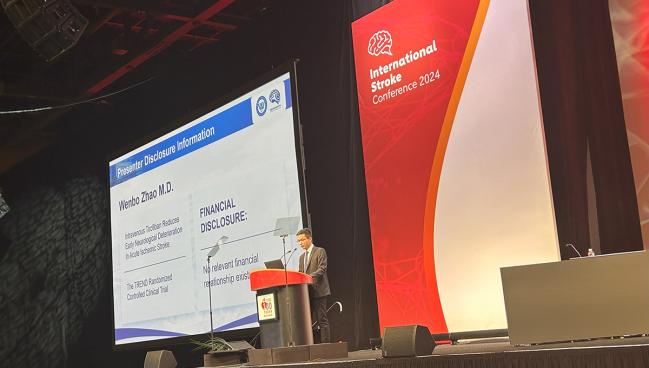Tirofiban May Cut Early Worsening After Acute Ischemic Stroke
The approach, which is “not ready for prime time,” didn’t improve 90-day functional outcomes versus oral aspirin.

PHOENIX, AZ—IV tirofiban lessens early neurological deterioration when given within 24 hours of symptom onset in patients with an acute noncardioembolic ischemic stroke who aren’t treated with IV thrombolysis or mechanical thrombectomy, the randomized TREND trial shows.
The proportion of patients with an increase in NIHSS score of 4 points or more in the first 72 hours was 4.2% among those treated with tirofiban and 13.2% among those treated with oral aspirin, a relative reduction of 68% after adjustment, Wenbo Zhao, MD (Xuanwu Hospital, Capital Medical University, Beijing, China), reported last week at the International Stroke Conference.
There were no cases of symptomatic intracerebral hemorrhage in either group, with similar rates of systemic bleeding with either tirofiban or aspirin. The early impact of tirofiban, however, didn’t translate into a significant improvement in modified Rankin Scale (mRS) scores at 90 days.
“Further randomized clinical trials,” Zhao said, “are needed to determine the efficacy of tirofiban for functional outcomes.”
Indeed, commented Seemant Chaturvedi, MD (University of Maryland School of Medicine, Baltimore), the findings of this trial are inconclusive considering the discrepancy between the earlier and later outcomes. It could be, he told TCTMD, that the early gain from tirofiban was diminished over time by rehabilitation and therapy or that the scales used to measure deterioration were too sensitive, with too little of a difference between groups to lead to an impact on 90-day functional outcomes.
Moreover, Chaturvedi said, there are many potential causes of deterioration—extension of the thrombus, brain edema, metabolic factors, and infection, for instance. “I think we need to take a step back and look at the potential causes of worsening in each patient, and some could potentially be responsive to tirofiban, and others may not.”
The strategy is worth being studying further in larger trials, but for now, it is “not ready for prime time,” he said, adding that it’s “certainly not something that clinicians are going to adopt right now in the absence of a documented improvement in 90-day outcome.”
The TREND Trial
Neurological deterioration is common after acute ischemic stroke, and some studies have indicated that dual antiplatelet therapy with clopidogrel and aspirin can help lessen this worsening. Another option is IV tirofiban, a glycoprotein IIb/IIIa inhibitor with rapid onset.
For the TREND trial, conducted across 10 comprehensive stroke centers in China, investigators evaluated tirofiban’s impact in patients with an acute noncardioembolic ischemic stroke. They enrolled 426 patients (median age 64; 29% women) who had a neurological deficit attributed to focal cerebral ischemia and an NIHSS score between 4 and 20 (median 5), were able to move the muscles in their paralyzed limb, and could be treated within 24 hours of when they were last known to be well; patients treated with IV thrombolysis or endovascular thrombectomy were excluded.
[It’s] certainly not something that clinicians are going to adopt right now in the absence of a documented improvement in 90-day outcome. Seemant Chaturvedi
Patients randomized to IV tirofiban versus oral aspirin were less likely to have early neurological deterioration (RR 0.32; 95% CI 0.16-0.65), with consistent results across various subgroups. A secondary outcome of neurological deterioration, defined by an NIHSS score of 2 or more, also was reduced with tirofiban (11.7% vs 23.6%; RR 0.49; 95% CI 0.32-0.75).
Various assessments of early changes in median NIHSS scores and of 90-day functional outcomes according to mRS scores hinted at a benefit of tirofiban, albeit without significant differences between groups.
The primary safety outcome was symptomatic intracerebral hemorrhage within 72 hours of randomization, and no patients met this endpoint in either group. There were no severe bleeds in either arm of the trial and one moderate bleed (in the aspirin group). The rate of mild bleeding was not different between the tirofiban and aspirin groups (6.6% vs 5.1%; P = 0.33).
Unanswered Questions
Commenting for TCTMD, Lee Schwamm, MD (Yale School of Medicine, New Haven, CT), said it’s exciting to be able to show a significant impact on early neurological deterioration but, like Chaturvedi, also called attention to the lack of effect on 90-day functional outcomes.
“That was a secondary endpoint, but it is an important endpoint because you have to justify the increased expense and availability of an intravenous tirofiban versus an oral aspirin,” Schwamm said. “It raises that question of: is a reduction in the early fluctuation or worsening of patients sufficient to warrant the implementation of a new therapy if at 90 days it no longer has a durable effect?”
There are many potential contributors to the disconnect between those endpoints, he said. It’s possible that the deterioration measured early after stroke was not persistent in some patients, with a recovery in status shortly thereafter. “If the early deterioration is a reflection of infarct expansion, then you would expect that difference to express itself in a worsening at 90 days,” Schwamm said, adding, “I think we need to know a little bit more about the nature of those deteriorations.”
There’s also a need to better understand the relative efficacy and safety of IV tirofiban versus both aspirin and clopidogrel, which also has been studied in this scenario, and to evaluate whether there are subsets of patients who would derive more benefit from an alternative to oral aspirin.
“I probably wouldn’t change my practice today,” Schwamm said, adding that it was encouraging to see that there was not an increased risk of symptomatic intracerebral hemorrhage with IV tirofiban, which had been a concern. “It’s very reassuring and exciting to see that this drug had a profound impact in the early stage, and I think there’s definitely a need for further studies to see if it can have an impact on long-term functional outcome, even just 90-day functional outcome, but I don’t think we have the full story yet.”
Todd Neale is the Associate News Editor for TCTMD and a Senior Medical Journalist. He got his start in journalism at …
Read Full BioSources
Zhao W. Intravenous tirofiban reduces early neurological deterioration in acute ischemic stroke: the TREND randomized controlled clinical trial. Presented at: ISC 2024. February 8, 2023. Phoenix, AZ.
Disclosures
- The trial was funded by the National Key Research and Development Program of China, the National Science Foundation of Beijing Municipality, and the Beijing Municipal Science and Technology Commission.
- Zhao reports no relevant conflicts of interest.




Comments